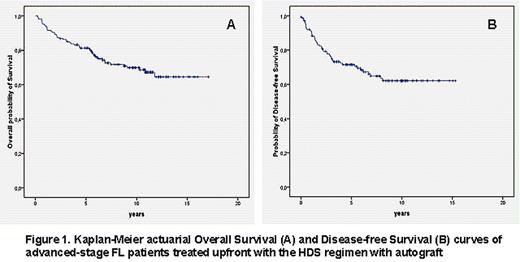Abstract
Abstract 882
Three consecutive trials have been performed in Italy over the last 18 years, to verify the efficacy of the use of High-Dose Sequential Chemotherapy (HDS) and autograft as first-line therapy for high-risk Follicular Lymphoma (FL) <60 yrs. We present the last update with 10 yrs. of median follow-up.
The HDS regimen has been previously described (Corradini P et al, Blood 1997; Tarella C et al, Stem Cells 1998). Briefly, it consists of intensive debulking (2 APO courses +/− 2 DHAP courses) followed by the high-dose phase, including the sequential administration of etoposide (2 g/sqm), methotrexate (MTX) (8 g/sqm) and cyclophosphamide (CY) (7 g/sqm). PBPC collection is scheduled after the last course to maximize the “in vivo purging effect” operated by high-dose chemotherapy. The final autologous stem cell transplant (auto-SCT) conclude the program, two conditioning regimen have been employed, either the BEAM schedule or the Mitoxantrone/L-PAM combination. In the most recent schedule, Rituximab was included in place of MTX. In details, 2 Rituximab doses were administered before CY, after CY and after auto-SCT, with the aim of further improving disease control and the in-vivo purging. The first trial was a single Center phase II study exploring both feasibility and efficacy of the HDS program as first line therapy in advanced-stage indolent lymphoma (1991-1998, 26 FL patients) (Tarella C et al, Leukemia 2000); a subsequent multicenter phase 2 trial was then started at national level (GITMO, Gruppo Italiano Trapianto Midollo Osseo), to verify the efficacy of HDS in advanced-stage FL in a multicenter setting (1996-1999, 92 patients) (Ladetto M et al, Blood 2002); lastly, a muticenter phase 3 study was performed together with GITMO and IIL (Intergruppo Italiano Linfomi) Centers, comparing Rituximab supplemented HDS (R-HDS) vs. CHOP-R in aaIPI 2-3 FL (2000-2005, 68 patients in the R-HDS arm) (Ladetto M et al, Blood 2008). Overall, 186 patients have been treated with HDS, updated results have been obtained for 168 of them. They all had a diagnosis of FL (grade 1-2: 71%) and always presented with advanced stage, their median age was 48 yrs., LDH was high in 48%, BM involved in 77%.
140 patients out of 168 (83%) attained Complete Remission (CR); there were 6 early toxic deaths (3.6%); 8 patients had Partial Remission (4.8%) and 14 had no response (8.3%), soon followed by disease progression. So far 14 patients (8.3%) developed secondary myelodysplasia or acute leukemia (sMDS/AL), and 7 patients (4.2%) had a secondary solid neoplasia. As of July 2008, 50 of 168 patients died, due to: i. early toxicity (6 patients); ii. disease progression (25 patients, 15%); iii. second neoplasia (12 patients, 7.1%); iv. other causes (7 patients, 4.2%). Thus, at a median follow-up of 10 yrs., 118 patients (70.2%) are alive, and 80 (48%) are in their 1st continuous CR (CCR), and most of them are also in molecular remission. The actuarial OS and DFS curves are reported in Figures 1A and B. The latest relapse has been recorded at 8 yrs since HDS. So far, 50 patients (30%) are presently in their 1st CCR between 8 and 16 yrs after HDS.
i. advanced stage FL treated upfront with the intensive HDS regimen had a prolonged survival, with median survival not yet reached after 10 yrs. of follow-up; ii. main causes of death were disease progression and both early and late toxic side effects; iii. approximately half of the patients are long-term survivors without any sign of disease recurrence. This suggest that a prolonged PFS and possibly the disease eradication should be pursued also in advanced-stage FL. Future studies will verify whether these therapeutic goals may be achieved with chemo-immunotherapeutic schemes at least as effective but less toxic and laborious than HDS program with autograft.
Tarella:Roche: Honoraria, research financial support. Ladetto:Roche: research financial support. Vitolo:Roche: Lecture fees. Rambaldi:Roche: Honoraria. Corradini:Roche: Honoraria.
Author notes
Asterisk with author names denotes non-ASH members.


